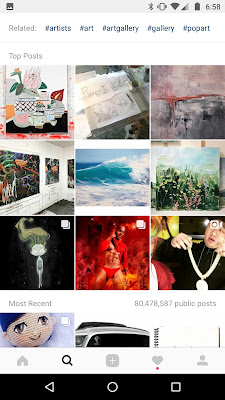Instagram is changing how buyers respond. Should it also change how artists paint?
 |
| Hashtag #pleinair. By the time you read this, the top nine will be something different. |
I haven’t painted in square format in a long time. The stark symmetry of the square can be lovely, but it can also be static. Recently, however, one of my daughters suggested that I start up again. “You should try painting for Instagram,” she said.
Instagram images started at 612px by 612px but have grown to 1080px by 1080px. (On your laptop or tablet, the images are scaled back down to 612px.) You can nab a few more pixels by posting portrait-format images. This made it easier for marketers to cross-post to Facebook. As someone who uses Facebook/Instagram marketing, I appreciate that.
While 1080px is incredible resolution from a wee little phone app, it’s not going to reproduce the subtleties of a masterpiece like Frederic Church’s Heart of the Andes. It skews art to the graphic-design side. What’s important isn’t how the work reads on a wall; what’s important is what it looks like on a phone. There’s nothing inherently wrong with that, but it does tend to leave subtler painting back at the Met.
| Hashtag #landscape is overwhelmingly photographic and mystical. |
The Instagram artist’s goal is to end up where newspapermen used to call “above the fold,” meaning on the upper half of the front page. That translates to being among the top images in a wildly popular category like #art. You’re not going to get there without great images. But you also need to discipline yourself to act like a trained monkey at times, to do things like randomly “like” posts by your followers, over and over and over.
The artist/gallerist has to wrap his mind around the fact that Instagram isn’t a way to flog paintings, it’s a medium in itself. It favors the bold and simple. Composition and color are key. Instagram users like video. And they aren’t librarians: even in a category like #pleinair, the top posts don’t necessarily have anything to do with painting.
| Hashtag #artist. Is that a Vampire Facial in the middle? |
Instagram flows both ways, of course. There are artists whose work is about the interaction of people and technology, like Jeanette Hayes. There are many more of us who’ve integrated Instagram and Google into our reference material. That makes the search engine roughly analogous to the camera in the 20th century. Instead of creating our own reference images, modern artists appropriate them from others. Yeah, I know that’s illegal and unethical, but appropriation is one of the major movements in modern art.
Then there’s the issue of what’s acceptable. “There is also a notorious censorship issue on the app that prevents real artistic freedom,” said Instagram darling Brad Phillips. “Sure, the official stance is that you can post pretty much whatever you want but sexual images (ones that do not violate Instagram’s terms around nudity) are often flagged and deleted.” That predates Instagram, of course.
 |
| Hashtag #art. If they print it, it must be true. |
All this is puts great pressure on the artist, particularly one trained in the 20th century, when there were very different ideals about craftsmanship and the meaning of art. I’m ambivalent about Instagram, but I ought to get past that. Should I change how I paint? I’m not sure I want to. Should I change how I photograph and present my work? Absolutely.
